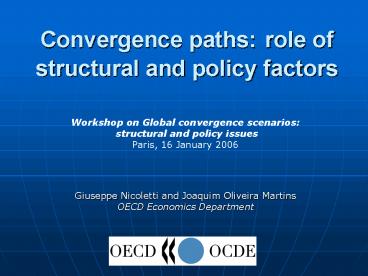Giuseppe Nicoletti and Joaquim Oliveira Martins - PowerPoint PPT Presentation
1 / 9
Title:
Giuseppe Nicoletti and Joaquim Oliveira Martins
Description:
Giuseppe Nicoletti and Joaquim Oliveira Martins. OECD Economics Department ... Which broad convergence scenarios can be envisaged? ... – PowerPoint PPT presentation
Number of Views:77
Avg rating:3.0/5.0
Title: Giuseppe Nicoletti and Joaquim Oliveira Martins
1
Convergence paths role of structural and policy
factors
Workshop on Global convergence scenarios
structural and policy issues Paris,
16 January 2006
- Giuseppe Nicoletti and Joaquim Oliveira Martins
- OECD Economics Department
2
Which broad convergence scenarios can be
envisaged?
- All countries converge to the same GDP per capita
level - Perfect mobility of factors
- Same endowments
- No segmentation of markets
- Technology diffusion
- All countries converge at same GDP per capita
growth, but different levels - Imperfect mobility of factors (notably labour)
- Different endowments (notably human capital)
- Market segmentation (notably services)
- Limited technology diffusion (different
incentives) - Possibility of either convergent or divergent
paths - Endogenous growth
- Agglomeration effects
Not very realistic
Tractable ?
Perhaps the more realistic, but difficult to
project
3
Conditional convergence, clubs and accelerations
Convergence within OECD (logs GDP per
capita) US and BRICs
Leader
Source Maddison (2003), data 1990 US PPPs
4
Ingredients of long-term projections
5
Labour utilisation
- Demographics is key to project growth (using
cohort approach) - Drag on growth of -0.3 to -0.5/yr in EU, -0.8 in
Japan over 2005-50 period in CHINA -0.3 to
-0.5/yr after 2025 - Increasing trends on labour participation in all
countries, but sometime reduced hours - Big gaps in participation of young workers, old
workers and women mostly related to institutional
settings in OECD and with cultural/demographic
factors in the South - What feedback mechanism of growth on demographics?
6
Labour productivity
- Capital deepening
- Endogeneity of saving rates (e.g. life cycle)
- Financial intermediation and development what
link? - Need a coherent view of capital flows
(importers/exporters of capital differences in
time preferences) - What feedback mechanisms?
- TFP growth
- Pure technical progress ?
- Capital quality May increase both in the North
and the South (ICT adoption) we now understand
better how catch-up is affected by technology
diffusion - Labour quality Contribution to growth is likely
to decline in the North and to increase in the
developing world
7
From growth rates to levels the role of policies
Leader
Convergence club
Log GDP per capita
Follower close PF
Sustained catch-up
Followers far PF
Growth acceleration
time
Policies III
Policies I
Policies II
8
What channels for policy?
- Macroeconomic framework as pre-condition
(liberalisation, stabilisation, financial sector
reform) - Policies affecting labour participation
- Participation Tax wedges Bargaining, EPL
- Links with social policies (pensions, health,
education) - Policies affecting labour productivity
- Human capital formation Enhancing competition
Incentives to adopt new technologies - Policy design is key
- Coherence/Complementarity role of institutions
- Adapt policies to distance to frontier (type
I-II-III)
9
But the debate is open
- What is endogenous? Growth or policies?
- Growth accelerations are not always associated
with major reforms How different is to sustain
and ignite growth? - Baseline (no-policy) vs. policy scenarios?
- Baseline only limited catch up in labour
productivity levels should be factored in on a
priori grounds - Policy scenarios convergence in levels could be
envisaged, but policies may be endogenous and
their design is critical to reap the benefits for
growth - Thank you!































